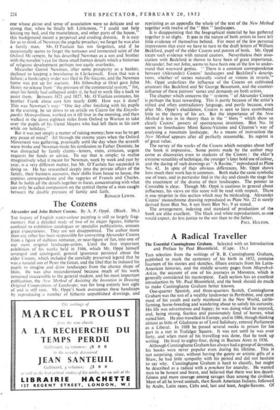The Cozens
Alexander and John Robert Cozens. By A. P. Opp& (Black. 30s.) THE history of English water-colour painting is still so largely frag- mentary that a detailed study of two of its friajor figures, hitherto confined to exhibition catalogues or specialist publications, arouses great expectations. They are not disappointed. The author more than any other has been responsible for converting Alexander Cozens from a figure of dubious romance, or near-figure of fun, into one of our most original landscape-artists. Until the first important exhibition of his works held in 1946, which Mr. Oppe himself arranged and catalogued, general ignorance persisted about the elder Cozens, which included the carefully preserved legend that he was a natural son of Peter the Great, and the libel that he induced his pupils to imagine and draw landscapes from the chance shape of blots. He was also misunderstood because much of his work remained inaccessible to the general student, and his most important publication, the New Method of Assisting the Invention in Drawing Original Compositions of Landscape, was for long entirely lost sight of and is still rare. Mr. Oppe's book overcomes these handicaps by reproducing a number of hitherto unpublished drawings, and reprinting as an appendix the whole -of the text of the New Method together with twelve of the" blot "landscapes.
It is disappointing that the biographical material he has gathered together is so slight. It was in the nature of both artists to have left little evidence of themselves behind. For most of the few personal impressions that exist we have-to turn to the draft letters of William -Beckford, pupil of the elder Cozens and patron of both. Mr. Oppe treats such evidence with natural caution. Nevertheless their asso- ciation with Beckford is- shown to have been of great importance. Alexander, but not John, seems to have been one of the few to under- stand that wayward genius. " There is a constant correspondence between (Alexander) Cozens' landscapes and Beckford's descrip- tions, whether -.of scenes naturally visited or visions in reverie." Mr. Oppe underlines the influence of the Cozens on cultivated amateurs like Beckford and Sir George Beaumont, and the counter- influence of these patrons' tastes and demands on both artists.
The chapter which concerns the" systems "of Alexander Cozens is perhaps the least rewarding. This is partly because of the artist's stilted and often contradictory language, and partly because, even after Mr. Oppe's elucidation, Cozens is seen to have contributed little to the theory of his art. But the importance of the New Method is less in its theory than in the " blots" which show so clearly Cozens' powers of spontaneous invention. Blot No. 16 seems to foreshadow Mont Sainte-Victoire and Cezatme's way of analysing a mountain landscape. As a means of instruction the New Method appears after all perfectly reasonable. Its reprint is of great value.
The survey of the works of the Cozens which occupies about half the book is impressive.. Some points made by the author may come as discoveries even to students of the Cozens : the elder's extreme versatility of technique, the younger's later bold use of colour, and the dating of such drawings as "A Ravine," reproduced as Plate No. 42. In spite of their obvious differences, Mr. Oppe shows how much their work has in common. Both make the same symbolic use of trees, and in particular find in the sky and clouds the stage for the enactment of the drama of their landscapes. The pointer to Constable is clear. Though Mr. Oppe is cautious in general about influences, his views on this score will be read with respect. There is one misprint in this section which may be misleading. Alexander Cozens' monochrome drawing reproduced as Plate No. 22 is surely derived from Blot No. 6 not from Blot No. 9 as stated.
The arrangement, indexing and standard of production of the book are alike excellent. The black and white reproductions, as one would expect, do less justice to the son than to the father.
PAUL HULTON.


































 Previous page
Previous page